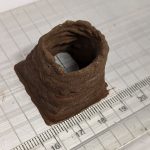A species of stink bug could become “problematic” for crops and gardens after it was discovered in Surrey, experts have warned.
The brown marmorated stink bug is native to Asia, can grow up to 1.7cm and gets its name from the foul smell it exudes when threatened.
A pheromone trap caught the bug at the Royal Horticultural Society Garden in Wisley, but there are growing fears over the invasive species rising in population.
During the summer, the pests live on fruits and vegetables by piercing the surface and sucking out the juice, distorting the produce and causing it to rot.
They can also invade houses in the autumn months, leaving stains on curtains and carpets.
Dr Glen Powell, head of plant health at RHS Garden Wisley, said: “The installation of pheromone traps at our gardens enable us to study invasive species from their arrival in the UK through to potential colonisation.
“While there is currently no evidence of breeding we would expect the stink bug to grow in prevalence and it may become problematic in gardens during summer and homes in the winter months within five-10 years.
Cost of living crisis: Energy and council tax bills could rise by hundreds of pounds from next year, warn experts
COVID news live: UK red list to be updated today – as county tells schools to reintroduce face masks amid rising infections
Andy Murray reveals he’s in ‘bad books’ with wife Kim after tennis shoes were stolen with wedding ring attached
“This isn’t a sudden invasion but potentially a gradual population build-up and spread, exacerbated by our warming world.
“The stink bug isn’t the first to land on our shores and won’t be the last, and understanding how we can best manage it is the next challenge for the research community supporting gardeners and commercial growers of fruit and vegetables.”
The pheromone trap lures the bugs in by releasing its naturally occurring scents to a sticky panel and are part of a project led by the Department for Environment, Food and Rural Affairs and the National Institute of Agricultural Botany
It’s not clear how the bug arrived in the UK or if the species can bread locally but it is believed the southeast of England is the northernmost limit for the bug’s potential range, although climate change means it could spread further.
There are more than 40 species of stink bugs in the UK, however, most pose no threat to plant health and are not considered pests.
A Defra spokesperson said: “The brown marmorated stink bug is not a significant threat but as with all pests and diseases we will continue to monitor any threats closely.”






















